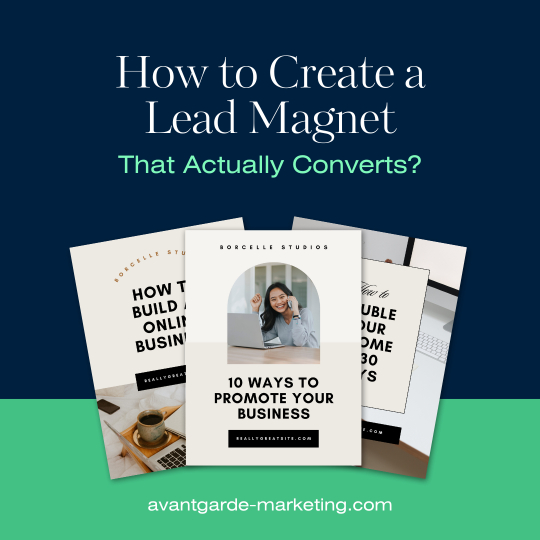
In today’s digital landscape, attracting and retaining customers is more competitive than ever. Businesses are constantly searching for ways to capture leads and move them through the sales funnel effectively. One of the most effective strategies is the use of lead magnets, but not all lead magnets are created equal. A well-crafted lead magnet can turn casual website visitors into loyal customers. Here’s how to create a lead magnet that actually converts.
1. Understand Your Audience’s Pain Points
The foundation of a successful lead magnet is its relevance to your target audience. Before creating anything, you must first understand the specific challenges, desires, and needs of your ideal customers.
Ask yourself:
• What are their pain points?
• What problems do they need solved?
• What information are they seeking?
The more you can tailor your lead magnet to address a pressing issue or provide value to your audience, the higher the chance it will convert.
2. Offer Immediate, Tangible Value
A lead magnet should offer something of immediate, tangible value. It needs to be irresistible—something your audience feels they need right now. Whether it’s a downloadable guide, checklist, or template, the content should provide a quick win for your potential leads. People are more likely to give you their email address if they believe they will gain something worthwhile immediately.
3. Be Specific
Broad, generic lead magnets often fail to capture attention. The more specific your offering, the more likely it will resonate with your audience. For example, instead of offering a “Digital Marketing Guide,” create something like “A 7-Step Checklist for Optimizing Your Facebook Ads Campaign in 2024.” Specificity demonstrates expertise and ensures your lead magnet is targeted to the right people.
4. Make It Easy to Consume
Your lead magnet should be easy to access and consume. If it’s a long, complicated eBook or video series, people may not find the time to engage with it. Instead, focus on providing quick, actionable insights. PDFs, one-page guides, checklists, or templates are excellent options because they are straightforward and offer immediate value without overwhelming the recipient.
5. Create a Visually Appealing Design
Design plays a crucial role in how your lead magnet is perceived. Even if the content is highly valuable, a poor design can make it less appealing. Use clean, professional layouts with compelling visuals, and ensure your brand identity is reflected in the design. A polished, professional look helps convey trustworthiness and expertise.
6. Craft a Compelling Headline
Your lead magnet’s headline is the first thing your audience will see, and it will determine whether they opt-in or keep scrolling. The headline should clearly communicate the benefit of your lead magnet and create a sense of urgency or curiosity. Use actionable language and highlight the value your audience will get.
For example:
• “10 Proven Strategies to Double Your Social Media Engagement”
• “Free Template: Create Your High-Converting Sales Funnel in Minutes”
• “Exclusive Checklist: How to Launch a Successful Product in 30 Days”
7. Optimize the Opt-in Form
Even the best lead magnet won’t convert if your opt-in form isn’t optimized. Keep the form simple and to the point. Ask for minimal information—usually just a name and email address. The fewer fields a potential lead has to fill out, the more likely they are to complete the form. Additionally, use a clear call-to-action (CTA) that reinforces the value of the lead magnet. Instead of a generic “Submit” button, try something like “Get My Free Guide Now.”
8. Promote the Lead Magnet Across Multiple Channels
Once you’ve created your lead magnet, promote it across all relevant marketing channels. This could include your website, social media platforms, email newsletters, and even paid ads. Use engaging visuals and strong copy to entice people to download your lead magnet. A well-promoted lead magnet can generate a steady stream of leads over time.
9. Follow Up with a Nurture Sequence
A lead magnet is just the first step in turning a prospect into a customer. Once someone opts in, it’s important to nurture them with a follow-up email sequence that provides additional value and builds trust.
Your nurture sequence could include:
• A welcome email thanking them for downloading the lead magnet
• A series of educational emails that dive deeper into the topic of the lead magnet
• Case studies or testimonials showcasing your product or service in action
• A gentle introduction to your paid offerings
10. Measure and Optimize
Finally, creating a high-converting lead magnet is an ongoing process. Track the performance of your lead magnet by monitoring key metrics like opt-in rates, engagement, and conversion rates. Use A/B testing to experiment with different headlines, design elements, or form fields. By continuously optimizing based on data, you can ensure that your lead magnet remains effective.
Conclusion
A well-executed lead magnet can be a game-changer for your business, helping you grow your email list and ultimately drive more sales. By understanding your audience, offering tangible value, and following best practices, you can create a lead magnet that actually converts. Remember, the key to success lies in providing immediate value and making it easy for your audience to engage.

